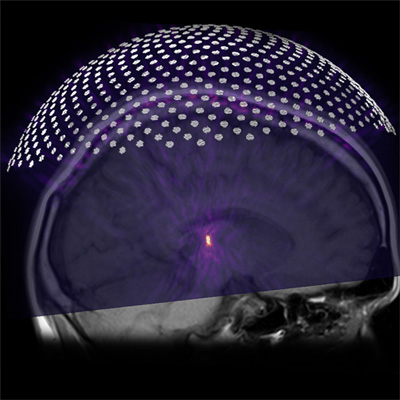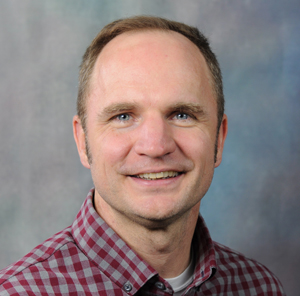
Researchers in the Vanderbilt University Institute of Imaging Science (VUIIS) are nearing completion of an ingenious undertaking that may be a high point of their careers — a nonaddictive alternative for relieving chronic pain.
Their invention, a focused ultrasound stimulation system that directs neuromodulating ultrasound signals deep into the brain under the guidance of magnetic resonance imaging (MRI), is being readied for clinical testing with the support of a three-year, $4.6 million federal grant awarded this fall.
The object of their quest, which began 10 years ago, is the relief of often-intractable neuropathic pain caused by stroke-related nerve damage in the brain. Current treatments relying on morphine, oxycodone, and other opioid drugs provide limited relief and can be highly addictive.
“Nondrug pain therapy — that’s what we’re aiming for,” said chronic pain researcher Li Min Chen, MD, PhD, who developed the technology with ultrasound expert Charles Caskey, PhD, and colleagues at Vanderbilt.

While other devices have been developed to treat chronic pain, they cannot precisely target pain circuits in the brain. “If we are successful, we will be the first” to conduct human testing of an MRI-guided, ultrasound-based pain therapy, said Chen, professor of Radiology and Radiological Sciences, Biomedical Engineering, and Psychology.
Sound waves emitted by ultrasound devices are used diagnostically to generate images of internal anatomy. But they also can modulate the activity of cells in the body, including nerve cells, said Caskey, associate professor of Radiology and Radiological Sciences, and Biomedical Engineering.
The major challenge has been guiding the ultrasound beam to the precise location of damaged nerves in the brain that are the source of the tingling and often-excruciating sensations of burning and stabbing pain throughout the body.

With former Vanderbilt biomedical engineer William Grissom, PhD, now at Case Western Reserve University, Caskey and Chen arrived at an elegant solution: an ultrasonic probe guided by functional MRI, a diagnostic technique that detects and monitors changes in magnetic signals reflecting neuronal activity in specific regions of the brain.
Supported by the National Institute of Neurological Disorders and Stroke (NINDS) through a National Institutes of Health initiative called HEAL (Helping to End Addiction Long-term), the researchers, who included VUIIS Director John Gore, PhD, developed a noninvasive system that can beam ultrasound waves through the skull deep into the brain.
Called an integrated, MRI-guided, focused ultrasound stimulation system, the device, which looks like an MRI head coil, combines functional MRI with ultrasound neuromodulation. This allows researchers to alter neuronal activity in brain regions associated with the perception of pain, while simultaneously monitoring the response in real time.
After demonstrating in preclinical studies that their device could modulate neural activity in pain centers in the brain under MRI guidance and functional MRI monitoring, further funding was provided by the NINDS this fall.
During the grant’s first, three-year phase, the researchers will work to overcome technical barriers in transcranial ultrasound, and ready the system for human use. After the successful completion of these milestones, additional funding will be provided to begin the second phase — a pilot clinical trial.
Clinical testing will be conducted in patients with essential tremor, a neurological condition that causes the hands to shake uncontrollably, and in a second group of patients with stroke-related neuropathy.
For Caskey, who trained as an electrical engineer, the research is a personal and professional milestone. It is pushing a technology he helped develop “to a space where you can actually have an impact for patients,” he said.
As a physician scientist, Chen said she has long had the desire to invent something that could help relieve her patients’ suffering. “I’m really excited,” she said. “We are so close!”
Gore, University Distinguished Professor of Radiology and Radiological Sciences, Biomedical Engineering, Molecular Physiology and Biophysics, and Physics and Astronomy, noted that these developments required the engagement of experts in different areas of technology and neuroscience. “VUIIS provides an exemplary environment for such synergy,” he said.
Collaborators include:
Benoit Dawant, PhD, Cornelius Vanderbilt Chair in Engineering, professor of Electrical and Computer Engineering, Computer Science, Biomedical Engineering, Radiology and Radiological Sciences, Neurological Surgery, and Otolaryngology-Head and Neck Surgery and director of the Vanderbilt Institute for Surgery and Engineering (VISE).
Dario Englot, MD, PhD, associate professor of Neurological Surgery, Neurology, Radiology and Radiological Sciences, Electrical and Computer Engineering and Biomedical Engineering and director of Functional Neurosurgery.
Tigran Kesayan, MD, assistant professor of Neurology and Anesthesiology.
Allen Newton, PhD, associate professor of Radiology and Radiological Sciences, and Pediatrics.
Xinqiang Yan, PhD, research associate professor of Radiology and Radiological Sciences and Electrical and Computer Engineering.
The study is funded by grant number 1UG3NS135551 from the National Institute of Neurological Disorders and Stroke. This content is solely the responsibility of the authors and does not necessarily represent the official views of the National Institutes of Health.












